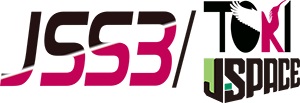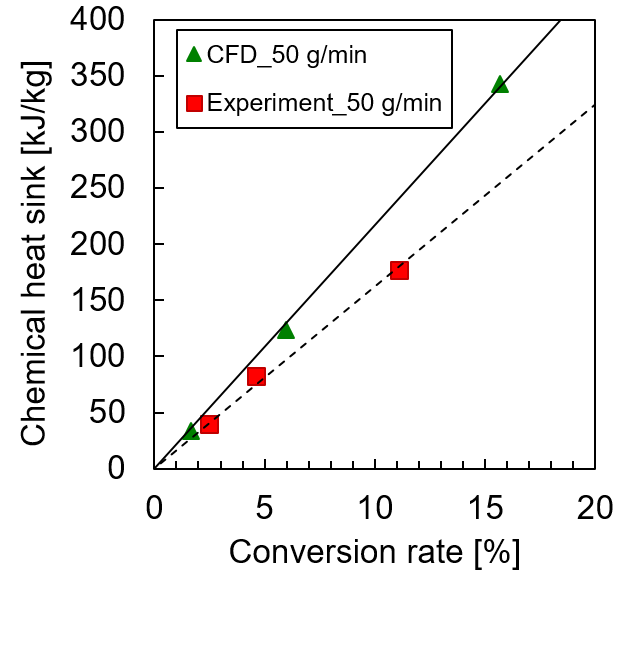Study on Future Space Transportation System using Air-breathing Engines
JAXA Supercomputer System Annual Report April 2017-March 2018
Report Number: R17EG3205
Subject Category: Research and Development
- Responsible Representative: Kouichi Okita, Research and Development Directorate, Research Unit 4
- Contact Information: Masatoshi Kodera kodera.masatoshi@jaxa.jp
- Members: Masahiro Takahashi, Masatoshi Kodera, Masaaki Fukui, Toshihiko Munakata, Masaharu Takahashi, Sadatake Tomioka, Akihiro Shimuta, Takuto Miyaura
Abstract
Recently, reusable rockets have been being studied to reduce the cost of space transportation systems significantly. However, in order to extend the structural lifetime, it is necessary to operate them with relatively low engine power, leading to a decrease in launch capability. Therefore, air-breathing engines such as scramjets and rocket/scram combined cycle engines are promising to compensate the drawback. By using air in the atmosphere as an oxidizer, the engine becomes highly efficient, and can be expected to maintain and improve the launch capability even if reused. In this project, we will research and develop key technology for practical application of the engine.
Reference URL
N/A
Reasons for using JSS2
The following points are raised as problems of engine design by ground experiments. 1) There are limits to reproducing various airflow conditions from takeoff to hypervelocity ranges. 2) Measured values are limited and complicated three-dimensional flow structures inside the engine can not be well identified. 3) Since the time and cost are limited, it is not easy to change the engine flow path configuration. Therefore, it is indispensable to utilize 3D CFD as a design tool, and a supercomputer is required for performing numerous CFD works efficiently.
Achievements of the Year
Subject 1: We continued to conduct a collaborative research with Tohoku University on construction of simple reaction mechanisms for high molecular hydrocarbon pyrolysis fuel from last year. In this fiscal year, we applied simple reaction mechanisms for methane / ethylene fuel mixture, which mimics a cracked jet fuel, to combustion CFD calculations including supersonic combustor flows. The results were compared to those obtained from a detailed reaction mechanism to validate the prediction accuracy and robustness (Fig. 1).
Subject 2: The validation of the combustion CFD using a LS-FLOW solver, which JAXA-JEDI has been developing, was conducted by comparing with the experimental results of the scramjet combustor model with gaseous ethelyne as a fuel. Some issures with the current RANS CFD have been clarified (Fig. 2, 3). The CFD was also applied to the simulation for undergoing combustion experiments with other scramjet combustor models to help understanding of the experimental results and those to evaluate combustor performance with modified flow-path design in advance.
Subject 3: RANS CFD on iso-thermal n-octane fuel flow within a tube to evaluate cooling capacity including thermal decomposition effects, was carried out with turbulence model and reduced chemistry and the results were compared to experimental results (Fig. 4). The deviation implied deficiencies in the reduced chemistry and the coking problem in the experiment.
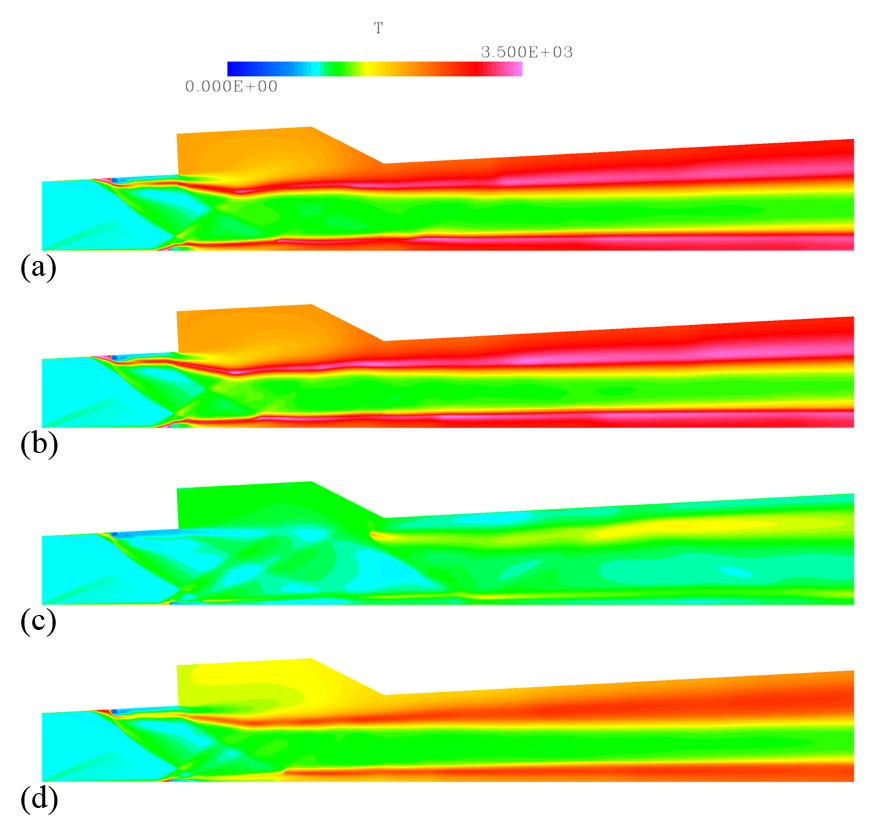
Fig.1: Comparison of CFD results (temperature distributions in supersonic combustor) obtained from simple and detailed reaction mechanisms ((a)-(c) simple mechanisms, (d) detailed mechanism)
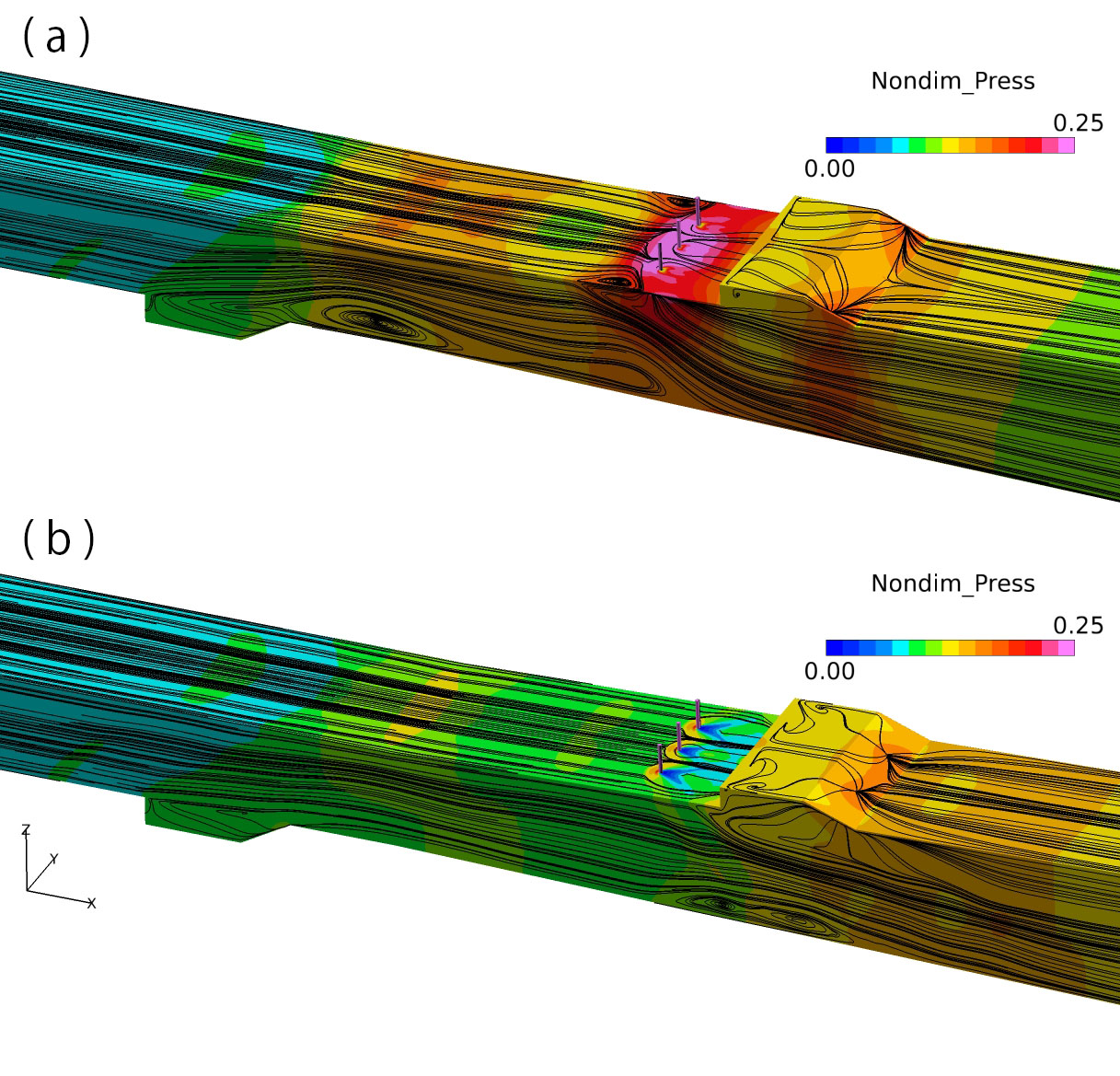
Fig.2: Comparison of the normalized wall pressure distributions and the surface streamlines on the ethelene-fueled scramjet combustor model obtained by RANS CFD with different turbulent Schmidt numbers (a) Sct = 0.3 (b) Sct = 0.89
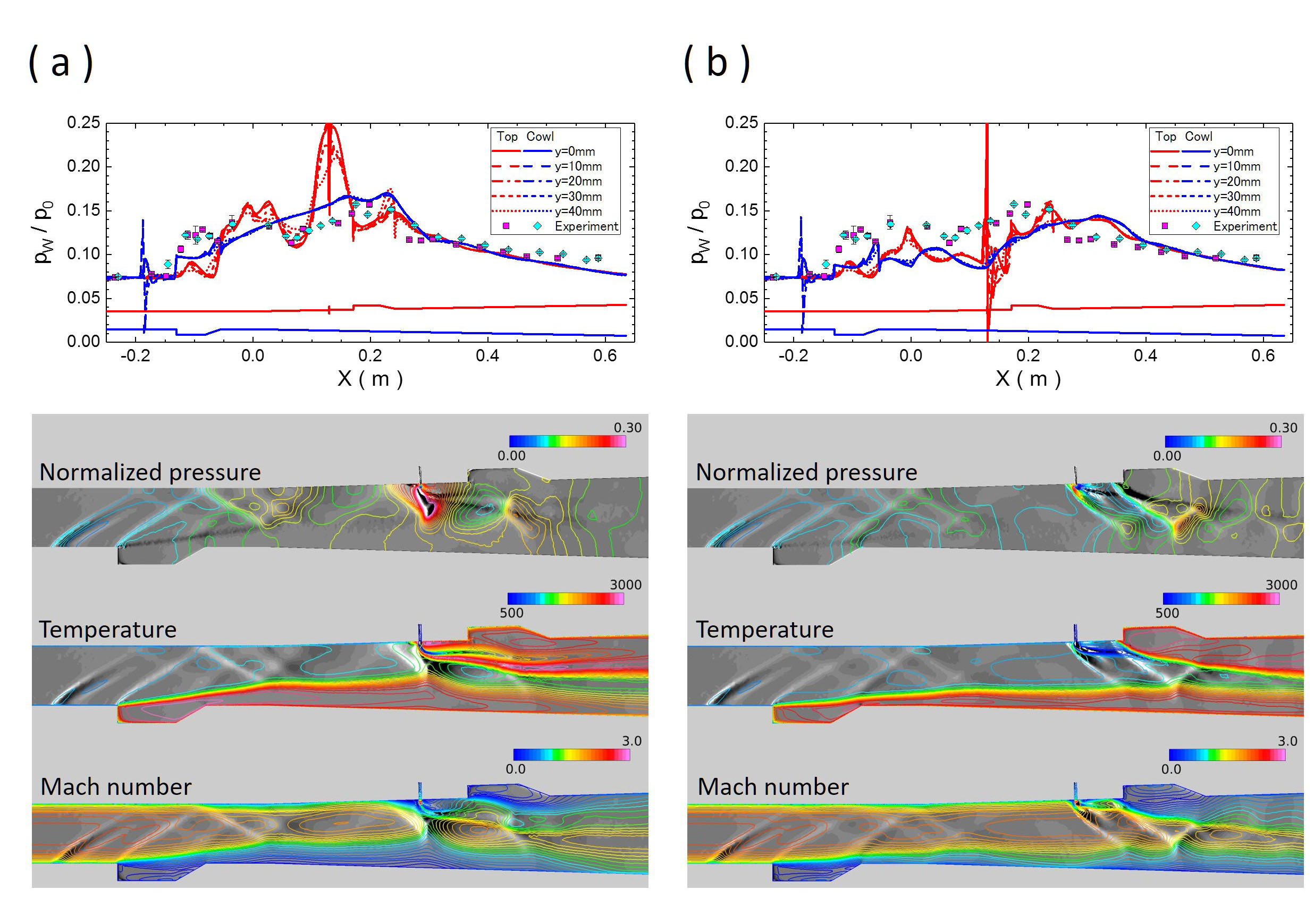
Fig.3: Comparison of the normalized wall pressure distributions and the cross-section profiles of the normalized pressure, temperature and Mach number obtained by RANS CFD with different turbulent Schmidt numbers (a) Sct = 0.3 (b) Sct = 0.89
Publications
■ Non peer-reviewed papers
1) Kodera, M., Tomioka, S., Sasaki, Y., Nakamura, H., and Maruta, K., “Application of Simple Reaction Mechanisms for CH4/C2H4 Fuel Mixture to Supersonic Combustor Flow Computations,” Proceedings of the 2018 Annual Meeting, Northern Branch of the Japan Society for Aeronautical and Space Sciences, 2018.
2) Takahashi, M., Nojima, K., Shimizu, T., Aono, J., and Munakata, T., “Numerical Simulation of Hydrocarbon-fueled Scramjet Combustor Flows by Using LS-FLOW Solver,” Proceedings of the 31st Symposium on Computational Fluid Dynamics, 2017.
3) Shimuta, A., “Research on Endothermic Heat Capacity of Liquid Hydrocarbon Fuel at Supercritical Condition,” Master Thesis, Tohoku University, 2018.
■ Presentations
1) Kodera, M., Tomioka, S., Sasaki, Y., Nakamura, H., and Maruta, K., “Application of Simple Reaction Mechanisms for CH4/C2H4 Fuel Mixture to Supersonic Combustor Flow Computations,” The 2018 Annual Meeting, Northern Branch of the Japan Society for Aeronautical and Space Sciences, 2018.
2) Takahashi, M., Nojima, K., Shimizu, T., Aono, J., and Munakata, T., “Numerical Simulation of Hydrocarbon-fueled Scramjet Combustor Flows by Using LS-FLOW Solver,” The 31th Symposium on Computational Fluid Dynamics, 2017.
3) Takahashi, M., Nojima, K., Shimizu, T., Aono, J., and Munakata, T., “Characteristics of Scramjet Combustor Flows with Ethelyne Fuel,” FY29 Space Transportation Symposium, 2018.
4) Miyaura, T., Shimuta, A., Daimon, Y., Tomioka, S., “Research on Endothermic Heat Capacity of Hydrocarbon Fuel at Supercritical Condition,” The 2018 Annual Meeting, Northern Branch of the Japan Society for Aeronautical and Space Sciences, 2018.
Usage of JSS2
Computational Information
- Process Parallelization Methods: MPI
- Thread Parallelization Methods: N/A
- Number of Processes: 32 – 1280
- Elapsed Time per Case: 72.00 hours
Resources Used
Fraction of Usage in Total Resources*1(%): 1.10
Details
Please refer to System Configuration of JSS2 for the system configuration and major specifications of JSS2.
| System Name | Amount of Core Time(core x hours) | Fraction of Usage*2(%) |
|---|---|---|
| SORA-MA | 9,220,531.74 | 1.22 |
| SORA-PP | 1,197.46 | 0.01 |
| SORA-LM | 69.74 | 0.04 |
| SORA-TPP | 0.00 | 0.00 |
| File System Name | Storage Assigned(GiB) | Fraction of Usage*2(%) |
|---|---|---|
| /home | 260.80 | 0.18 |
| /data | 6,000.80 | 0.11 |
| /ltmp | 9,765.63 | 0.74 |
| Archiver Name | Storage Used(TiB) | Fraction of Usage*2(%) |
|---|---|---|
| J-SPACE | 2.88 | 0.12 |
*1: Fraction of Usage in Total Resources: Weighted average of three resource types (Computing, File System, and Archiver).
*2: Fraction of Usage:Percentage of usage relative to each resource used in one year.
JAXA Supercomputer System Annual Report April 2017-March 2018

